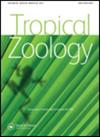Surveys of mammal communities in a system of five forest reserves suggest an ongoing biotic homogenization process for the Niger Delta (Nigeria)
IF 0.7
4区 生物学
Q4 ZOOLOGY
引用次数: 57
Abstract
Community composition and an index of relative abundance were analyzed for mammals (excluding most rodents, shrews and bats) of five forest reserves in the Niger Delta (Southern Nigeria). Twenty-nine species were recorded, 86.2% of them being found in all protected areas. Although most of the species were already known from the study area, there were unexpected patterns concerning the duikers. Indeed, the presence of only one species (Philantomba walteri) (CH Smith, 1827) was confirmed, whereas at least five additional duiker species were reported for the study area by earlier authorities. Another duiker species (Cephalophus niger Gray, 1846) was recorded once during the present surveys and is not known whether it represents a stabilized presence in the Niger Delta. The empirical Abundance Index suggested that only three species were very rare (Trichechus senegalensis (Link, 1795), C. niger, and Pan troglodytes (Blumenbach, 1775)). Diversity-dominance diagrams showed that the evenness profiles were similar across study areas. Linear distance (Km) between the barycenters of forest reserves was significantly positively correlated with relative community composition dissimilarity. Overall, a biotic homogenization process for the mammal communities of the five forest reserves was observed, likely as an outcome of the high deforestation of the last 50 years.对5个森林保护区哺乳动物群落的调查表明,尼日尔三角洲正在经历生物同质化过程。
对尼日利亚南部尼日尔三角洲5个森林保护区哺乳动物(不包括大多数啮齿动物、鼩鼱和蝙蝠)的群落组成和相对丰度指数进行了分析。共有29种,其中86.2%分布在所有保护区。虽然大多数物种在研究区域已经为人所知,但关于杜克的模式却出乎意料。事实上,只有一种(Philantomba walteri) (CH Smith, 1827)被证实存在,而早期的权威机构在研究区域报告了至少五种额外的duiker物种。在目前的调查中,曾记录到另一种小鳄(尼日尔灰头鲨,1846年),但尚不清楚它是否代表尼日尔三角洲的稳定存在。经验丰度指数显示,仅有3种非常罕见(Trichechus senegalensis (Link, 1795)、C. niger和Pan troglodytes (Blumenbach, 1775))。多样性-优势度图显示,各研究区均匀度分布相似。森林保护区重心间的线性距离(Km)与群落组成的相对差异呈显著正相关。总体而言,观察到五个森林保护区哺乳动物群落的生物同质化过程,这可能是过去50年森林砍伐的结果。
本文章由计算机程序翻译,如有差异,请以英文原文为准。
求助全文
约1分钟内获得全文
求助全文
来源期刊

Tropical Zoology
生物-动物学
CiteScore
2.50
自引率
0.00%
发文量
1
审稿时长
>12 weeks
期刊介绍:
Tropical Zoology is an international zoological journal publishing original papers in the field of systematics, biogeography, phylogeny, ecology and conservation of all terrestrial and aquatic animal Phyla from tropical and subtropical areas.
Only papers with new information, high quality and broad interest are considered. Single species description and checklists are not normally accepted. Review papers are welcome. The journal is owned by the Istituto di Ricerca sugli Ecosistemi Terrestri of the Consiglio Nazionale delle Ricerche, Florence, Italy (CNR-IRET) who performs research into the structure and functioning of aquatic and terrestrial ecosystems, focusing in particular on anthropogenic pressure and global change. The knowledge amassed forms the scientific basis for identifying the most appropriate protective and corrective interventions, and provides support for the bodies entrusted with formulating policies for environmental protection and recovery.
 求助内容:
求助内容: 应助结果提醒方式:
应助结果提醒方式:


